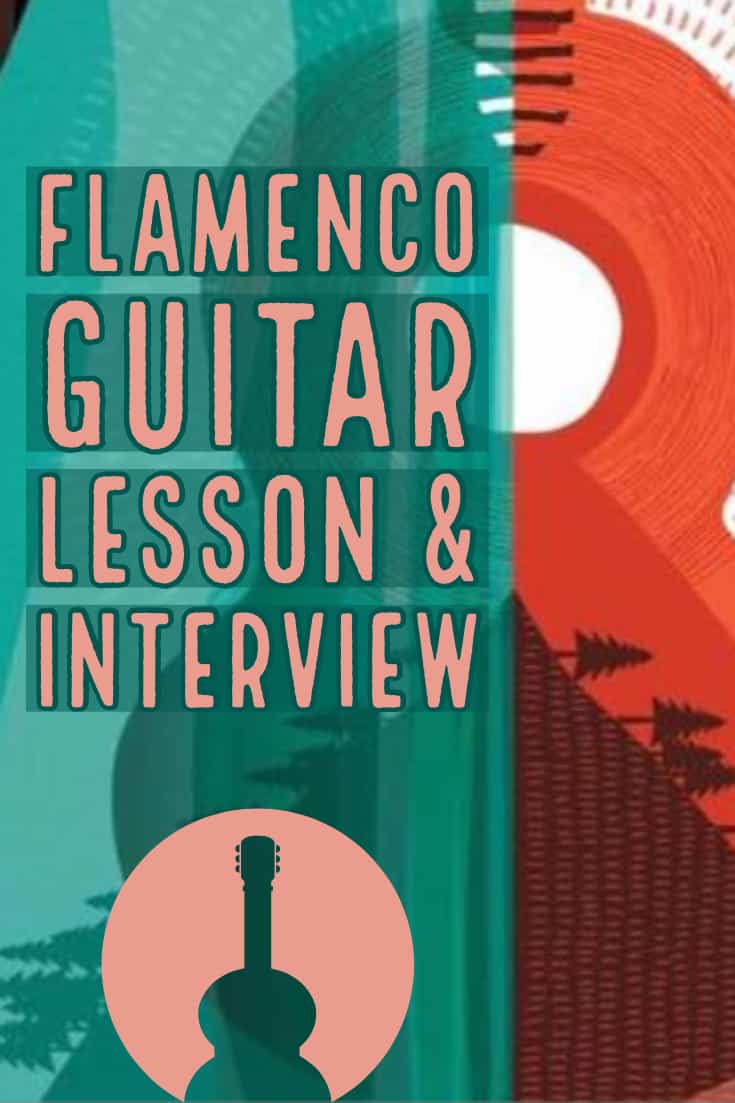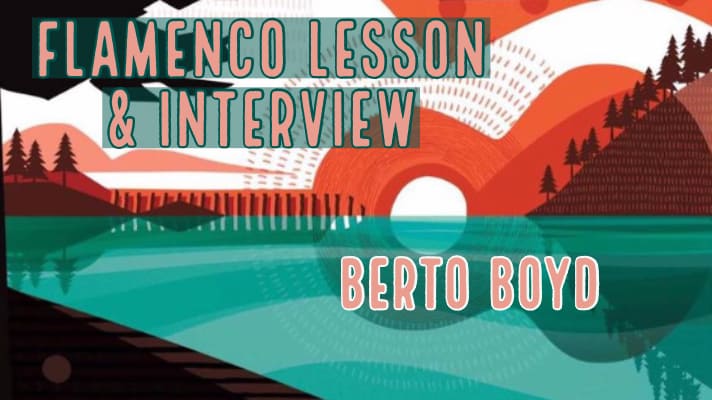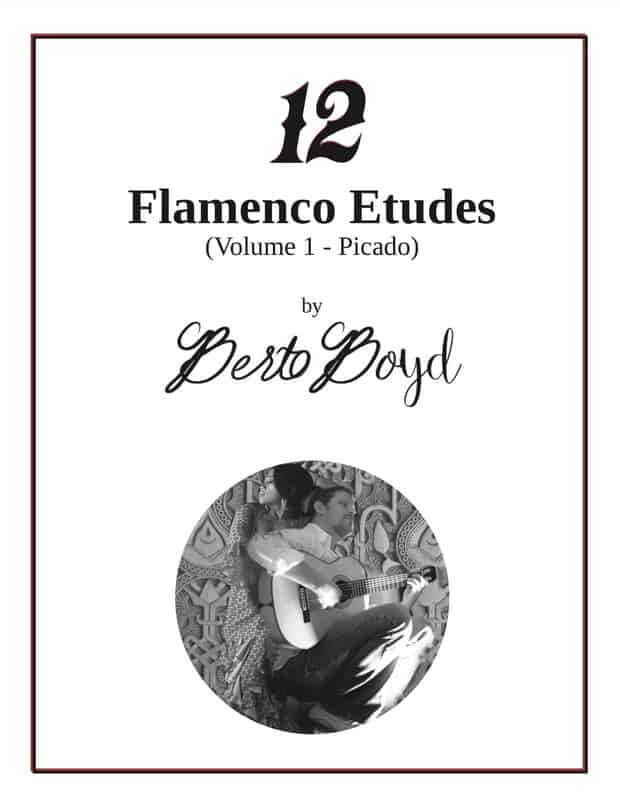Flamenco Guitarist Berto Boyd updated 2024. (Recently moved to Philippines)
I came across Flamenco and Classical Guitarist, Berto Boyd, on Facebook a while back through our mutual friend and guitarist, Ben Woods. I admire anyone who (like me) is able to make a living playing guitar at any level.
I’m also just a huge fan and admirer of Flamenco guitar in general. It’s not something I’ve covered yet here on Life In 12 Keys.
Guitarist Berto Boyd has a passion, depth and sophistication in his playing and musicianship that is a rare and beautiful thing that we can all learn from as guitarists.
Astounding technique and a real connection to both Classical and Flamenco repertoire. His original compositions also set him apart in my mind. Berto Boyd is a real gift to guitar fans everywhere.
…He also skateboards. Yeah, it was a bit of a factor when I was looking for my first Flamenco guitarist interview and lesson. As a 40-something guitarist and skater myself, I thought it was pretty cool that a musician of this caliber also skates. …and at our age!
I also thought it would make for a fun interview and something we could possibly have in common. …besides our mutual love of the guitar and Paco De Lucia…
Let’s get to it!
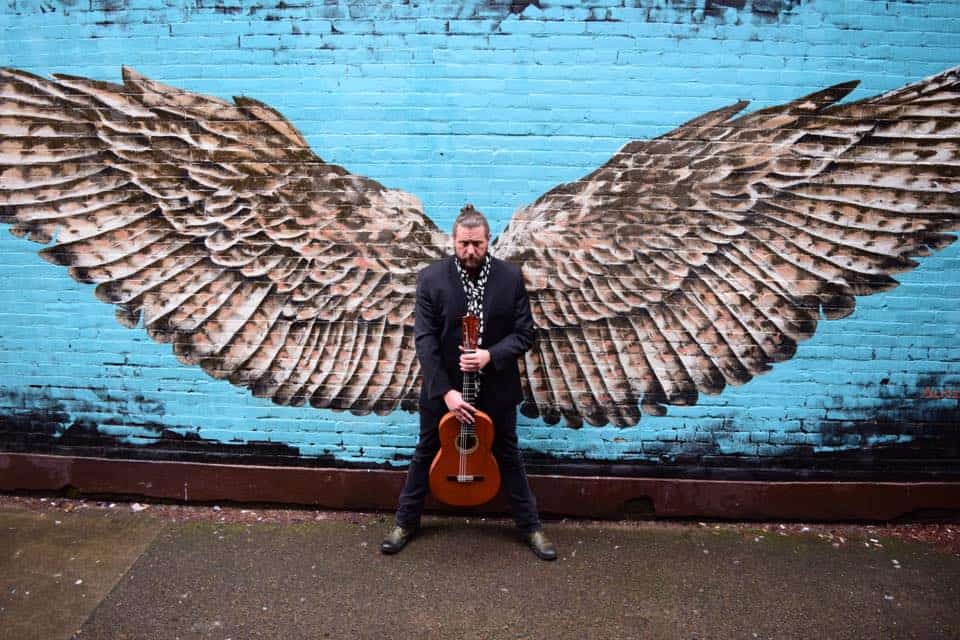
Interview With Guitarist Berto Boyd
Craig @ LifeIn12Keys.com:
Hi Berto and thanks for doing this! I’m absolutely thrilled to have you and appreciate you taking the time to talk to me and my readers.
Berto: “My pleasure man, let’s do this!!”
Craig:
When I was about 19, I was studying with a Berklee guy in Akron, Ohio who turned me on to the guitar trio albums with Al Di Meola, John McLaughlin, Paco De Lucia. As a young rock and metal guy, I had never heard anything like it.
It’s something that has stuck with me in the years since and has shaped my playing greatly.
What is it about Flamenco guitar that drew you in? Most guitarist (at least here in the U.S) don’t start with Flamenco. Tell me about your early influences and how you got into it?
Guitarist Berto Boyd Origins
Berto:
I’m originally from SoCal and grew up surrounded by music, art, surfing, and skateboarding. However, during 85’-89’ I lived on Dog River in Mobile, AL of all places.
My Dad was chill enough to build us a half-pipe in the backyard. This always attracted an alternative crowd that led to an abundance of counter-culture for the area at the time.
We would blast our boom box during the skate sessions. Someone always had a tape they wanted to pop in to get hyped on. We listened to a lot of Beastie Boys, Sex Pistols and Circle Jerks. When my sister’s Heshen boyfriend and friends came over they insisted we listen to metal.
Metal and Beyond
I remember one of the tapes my sis’s boyfriend loaned me was Sepultura’s “Schizophrenia”. There was a track on that tape (The Abyss) I would always rewind and want to listen over and over.
Little did I know this track was actually based off of a traditional Flamenco form called “Taranta”. Taranta is a rhythmically free form piece in the key of F# altered Phrygian. This was the coolest thing I had ever heard and my ears were very drawn towards the evocative sounds.
Berto Boyd on Developing Ear
My ear over the next few years was always pulled to whatever melodic finger-style stuff I could find. Mobile was’t exactly a place I would stumble across someone playing Classical or Flamenco. As a result, it would be a few more years till I discovered “the sound” I was looking for.
I learned by ear and through tabs a lot of quasi-Classical Metallica stuff. This included Anesthesia, Call of Ktulu, Fade to Black, To Live is to Die etc., al.
Fast forward to the early 90’s I was living in Ventura, CA. My Mom and I would order CD’s from the Columbia House Collection until we finally stumbled across John Williams. Once I finally knew what Classical Spanish guitar was, we investigated and tracked down CDs by Segovia, Julian Bream etc.
So around the same time I was listening to Classical guitar albums and picking stuff out by ear. As it would turn out, my fate had finally arrived. I was walking through Ventura College one day and I stumbled upon a classy gentleman named Carlos Gonzales. He was playing Heitor Villa-Lobos and it stopped me dead in my tracks.
Classical Guitar
It turned out, he was the guitar instructor there and classes had just started that week. I had a million questions for him which he gladly answered.
He told me I had to take 18 units to get the private lessons. I ran home to tell my Mom the news. That afternoon I knew what my mission was in life. To become a Classical guitarist. Luckily when I came home my Mom was super supportive and all in.
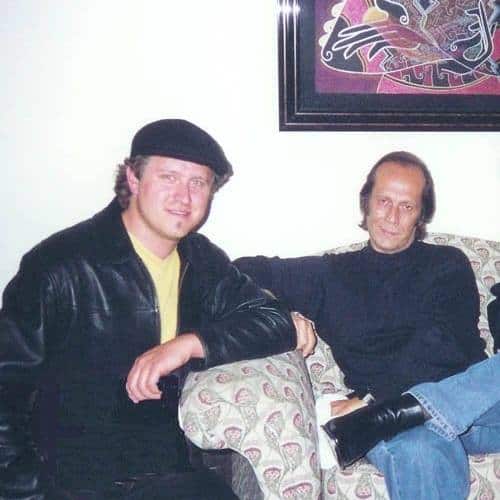
During that time I studied Classical guitar, Theory, and Composition at Ventura College. I started listening to a bit of more pop Flamenco stuff like the Gipsy Kings, Ottmar Liebert etc..
I hung with a crew of hippy dudes that played a lot of hand drums. I then started to develop my own version of Flamenco and Bossa Nova style just through jamming.
After 2 years of studying Classical, my teacher Carlos set up my first proper recital at a church. The following week after the recital I kinda got chewed out by him. It was because of all the “additions” I made to these Classical pieces.
I created a few intros and changed a few things. While it was to my liking, it apparently was a no go for him.
Guitarist Berto Boyd Getting Exposed to Flamenco
He told me “Classical musicians are limited to interpretation”. If I wanted to improvise like that then I should go play Flamenco. He gave me Pepe Romero’s “Flamenco!” CD which I instantly went home and started picking things up by ear.
A few weeks later my mom took me to see a Flamenco troupe from Spain. Once again my fate had been sealed. Once I experienced the spine-tingling duende, I knew exactly what the next step was. ….to now become a Flamenco guitarist and officially cross over to the dark side!
For the next few years I studied with several Flamenco teachers from Santa Barbara to L.A. Finally in 1999, I went to Spain to study with Gerardo Nunez.
Return From Spain
I returned from Spain with 35 Flamenco CD’s and started to transcribe pieces I wanted to add to my repertoire. At first I wrote stuff in tab and just memorized the rhythms in order to learn the piece. I also had been studying Brazilian Jazz and was learning how to properly chart out tunes.
Eventually I started using Finale notation software to plug in my hand written transcriptions. This really opened up some doors for me.
Craig:
As a part-time Classical Guitarist myself, I’ve always told my own students; Flamenco and Classical Guitar are absolutely the hardest styles to play. I see your Facebook posts about putting in a minimum of 4 hours a day to keep it up.
What does a typical practice day look like for you, let’s say on a day you don’t have a performance?
Guitarist Berto Boyd on Practicing Guitar
Berto:
Well I don’t always have 4 hours to put in, but I do see practice as a cumulative process. It’s easy to get into practice routines that become easy over time and you plateau out. I try to find “unfamiliar” things (my word for hard material) to constantly focus on.
I think if it as cross training in a way. I’ll sometimes have to play a certain new technique or study 6 months and longer till I get that breakthrough.
Musicians these days have to wear so many hats that you have to be organized & efficient in your practice time. In my early years especially when I returned from Spain I felt I had a ton of catching up to do. I felt I was really behind on a lot of the most basic things in Flamenco.
I really thought I knew some stuff when I went to Spain. I soon realized I didn’t know how to play for Cante (singing) or Baile (dancing).
Practicing Guitar
I felt I had to double up for a few years. As a result, I ended up doing an unhealthy amount of playing around 12-18 hours a day till I finally injured my hand.
After that, I restarted my technique from the ground up over a 6 month period. I did this under the tutelage of Adam Del Monte. I learned to play more efficiently with the right amount of tension and have never looked back.
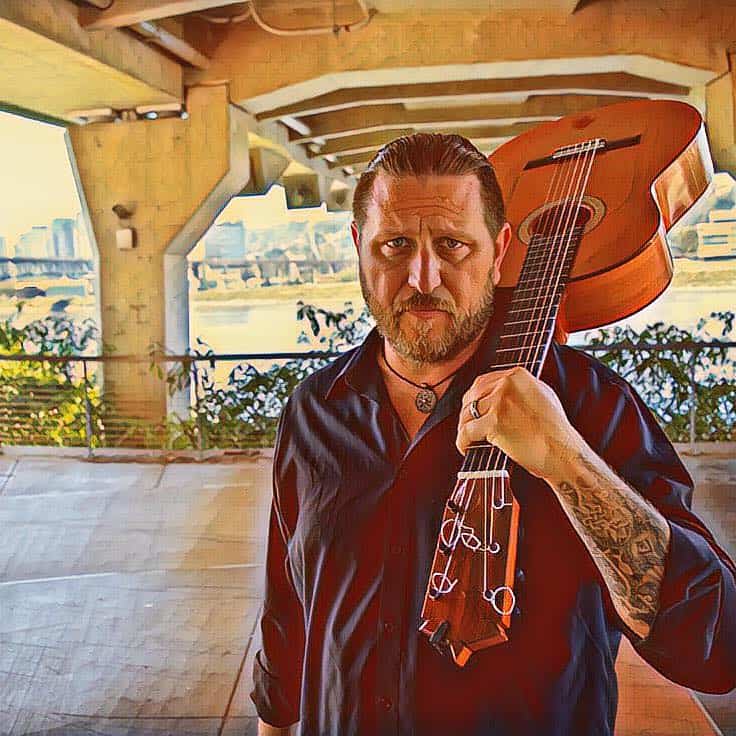
Craig: Would you mind sharing an outline or list of what your practice routine looks like? For example time spent on technical exercises, repertoire, composing, etc.
Berto:
As a minimum; I try and practice 90 minutes on a daily basis of scales and various techniques to keep things in shape. I practice with the same little Radio Shack timer I’ve had for several decades to keep myself honest.
So when I get interrupted or have to pause to rest my hands I hit the timer.
I have several routines that I follow. They all start with a 6-10 minute left-hand only warm up that focuses on placement and pressure. I then usually warm up my right hand with Etude No. 2 or 4 from my book.
I usually will do things in 3’s. For example:
- I’ll play a scale study with picado (alternating i,m) Rest stroke, Free stroke.
- A combination of the two.
- Then I’ll play it 3 finger usually M,I,A the same way, Rest, Free, Combo.
- I usually go to the CAGED system that I borrowed from my Rock days and play in major keys of C,G,D,A,E,B.
- I’ll pick usually 3 different patterns to run through each CAGED sequence in each key.
- My next book will be mostly focused on CAGED. It will have many of the patterns and speed bursts that we use in Flamenco.
However, when I’m preparing for a concert or a tour my routine can vary a great deal. So if I’m prepping for a Flamenco Pacifico tour, I know I’m playing my own music. I know my scales have to be up which means a major focus on picado and various thumb/ alzapua sequences with a metronome.
I will also play all the pieces with my two favorite apps:
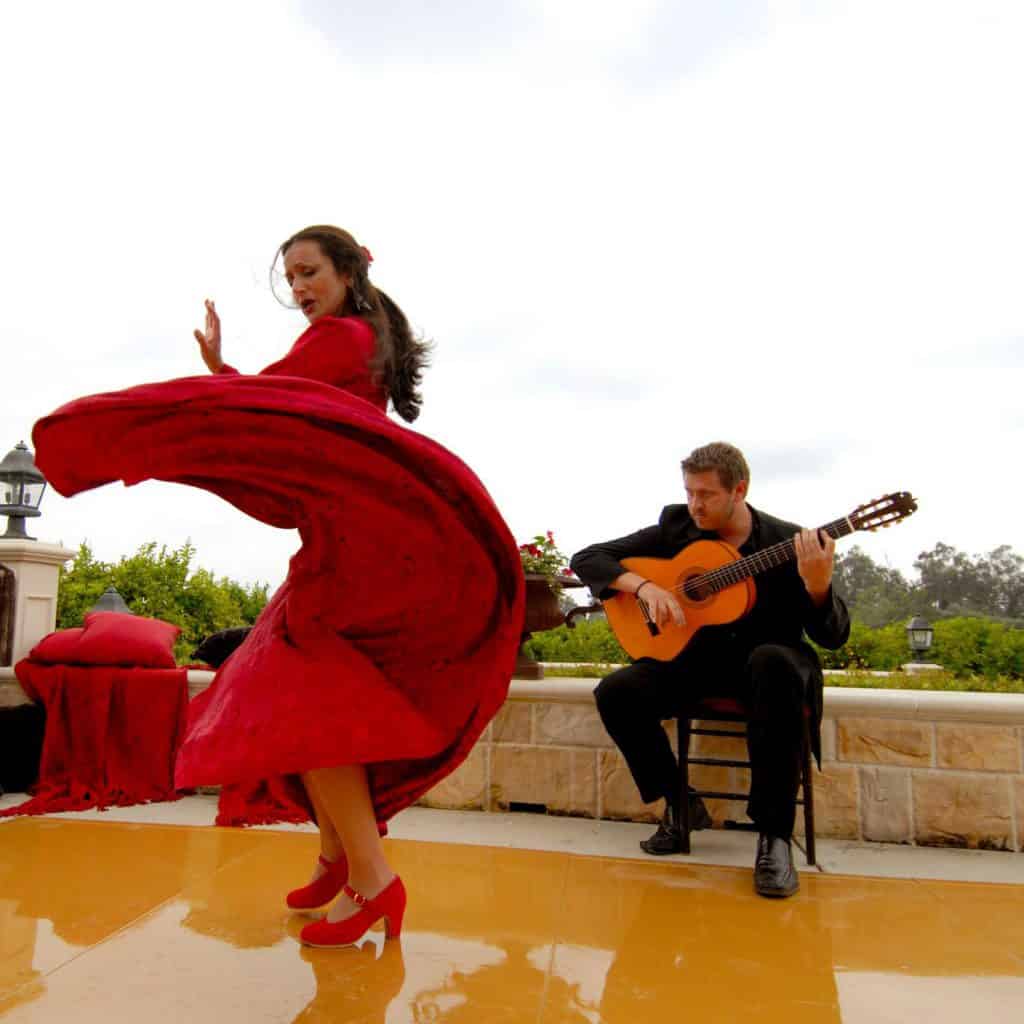
Dr. Compas Flamenco Metronome or with the album track on Amazing Slower Downer. I’ve become a big fan of slow focused practice in the past few years. Many times I’ll play at 60% of the tempo and then bump it up from there in increments of ten BPM each time till I get it to concert tempo.
Recently I discovered another way of doing this slow – to A tempo practice through the App: Soundcorset
Concierto en Re
Prepping the “Concierto en Re” by Mario Castelnuovo-Tedesco last year, I had to practice things at least 20 clicks past the performance tempo. Soundcorset has this cool feature that you can plug in the duration you want to spend at each tempo. This is before it goes up 1 BPM.
I have to say though be cautious with this feature! If you go crazy on it and go too long you’ll end up with some serious tendonitis! I’m sure that if I had this technology 20 years ago I would have destroyed my hands. Be careful and take breaks after each bout!
Approach to New Guitar Repertoire
Craig:
How do you approach new repertoire, for example a Classical piece? For example, do you sight-read a few times then try to memorize? Things like that,,,
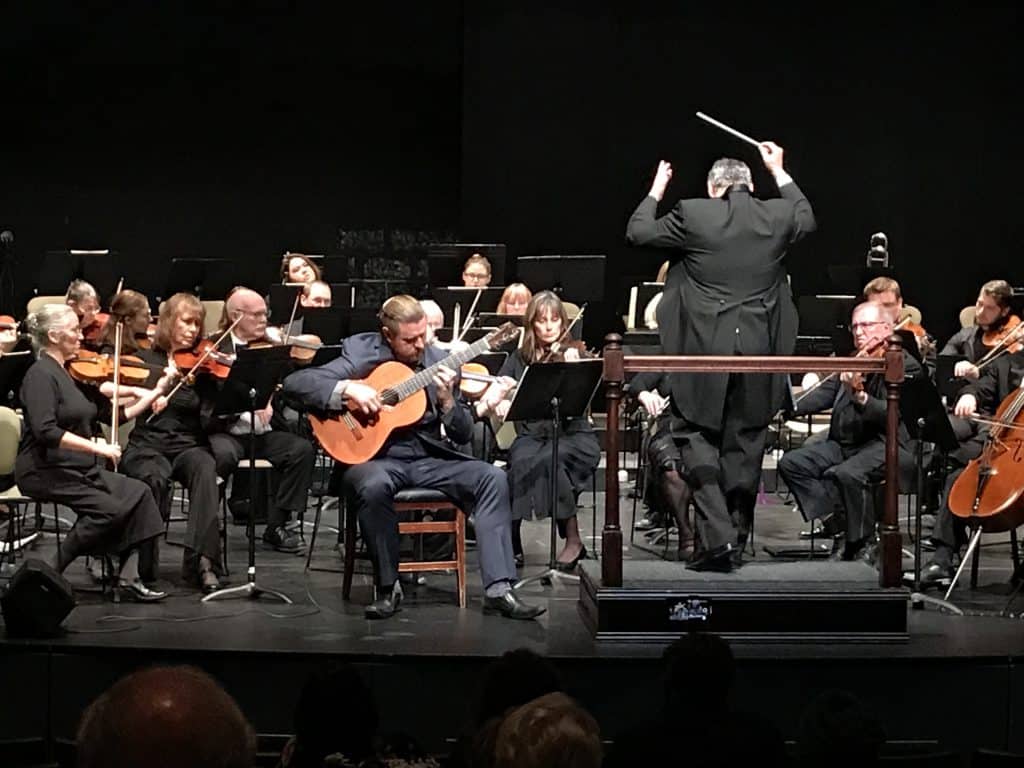
Berto:
When learning a new Classical guitar work I listen to it over and over. Then I write out a harmonic analysis. After I know the piece in my head I’ll then identify the most difficult technical sections. The parts that will need the most work. Many times I go directly to those parts and start writing out all the different fingering options.
I’ll usually play these difficult passages with all of the different right hand fingerings I could come up with. I’ll do this until I find the best one and then I’ll get to the rest of the piece. Sometimes I actually start from the end and work backwards.
You have to even out all the parts in my opinion. It really depends on the piece for the approach I take.
Craig:
While I’m writing this, I’m in the midst of 5 gigs this week. How do performances affect your own practice schedule?
Personally, I find it better (for me) to ease up and not blow my hands out on gig days.
On Guitar Practice Schedules
Berto:
I started my career as a guitar teacher. Teaching led into background music gigs and playing a ton of corporate gigs and weddings. I was able to afford a nice lifestyle in Santa Barbara from these gigs. As a result, after a decade or so I got seriously burnt out.

I wanted to play concerts, compose, and record, and most importantly, be inspired… In 2008 the career that I had built fell apart when the economy collapsed. My cushy resort gig soon vanished. All my corporate clients had to stop the lavish spending and so almost overnight the phone stopped ringing.
I decided this was the time to make a clean break from having to make 6k a month to cover my expenses.
Musician Lifestyle
I drove a Mercedes and lived across the street from Kenny Loggins. I didn’t however, have a dime in savings and was completely delusional. That was when I decided to let it all go and file for bankruptcy.
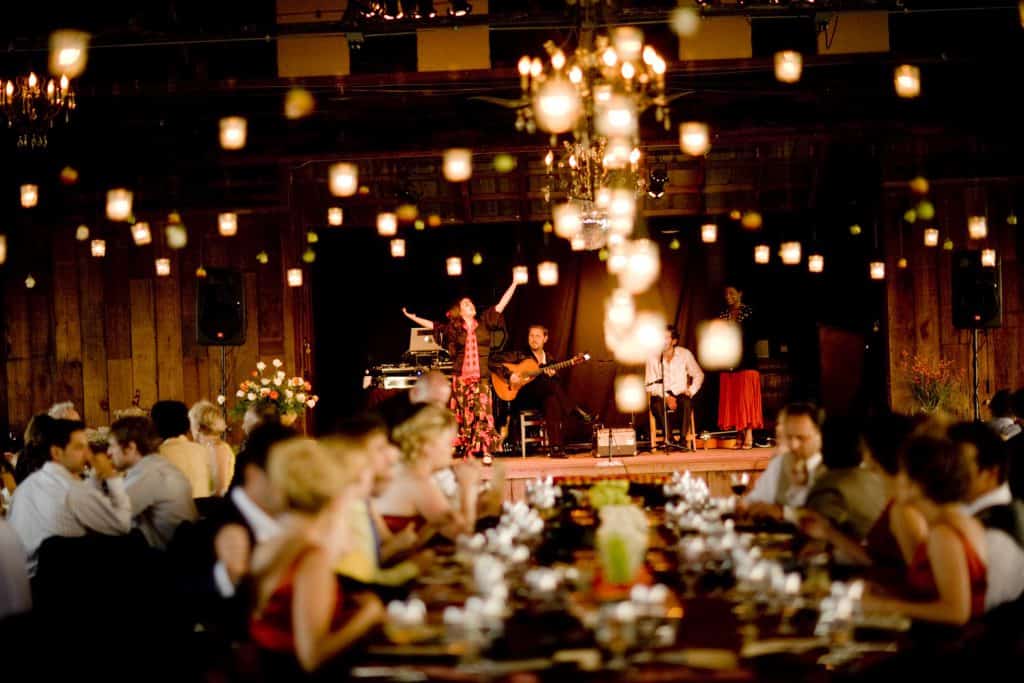
Meeting his Wife
At this timer I moved back in with my Mom. I rented a tiny studio and started practicing 8 hours a day again. I was determined to make a concert career but a bit unsure about how to go about it. About a year later I met my wife. She hired me for a party for a group of Filipino doctors.
We fell in love and decided we’d start a family. She’d pay the bills, I’d be the stay at home Dad. I’d have the time and resources to figure out this concert career. When my daughter turned 2 we decide to leave California and move to Oregon. I figured starting fresh somewhere would be the best thing.
Moving to Oregon
We moved to Corvallis, Oregon where I began the Corvallis Guitar Society. I was playing a lot of Classical Guitar when I moved to Oregon. I had taken a few years to restart my technique from the ground up. I would spend 2 hours a day on developing free stroke scales. I’d also play between rest and free stroke (a Scott Tennant specialty).
I would spend a few hours playing repertoire but not like you would think. I would play super slow with really awkward fingerings. Mainly I worked on 3 Barrios pieces – Estudio Concierto, Las Abejas, and La Catedral (allegro movement).
Focusing on Flamenco Guitar
After a few years in Oregon I decided to focus on my original Flamenco music again. This move has given me more freedom in the way that I practice. I play between 2-4 hours a day now on a regular basis. I usually am always practicing with the next concert in mind so that’s what decides what I work on.
On concert days I try to only practice 1-2 hours and usually like half tempo.
Flamenco Guitar Lesson – Berto Boyd Book
Craig:
I just purchased your book, 12 Flamenco Etudes Vol. 1 – Picado yesterday. I plan to get into it this week (before this goes live). Tell us about it.
Berto: I’ve been writing studies for myself for over 20 years to continually develop my technique.
This book is focused on what I’ve been personally working on for the last few years.
Technique
Every guitarist has their own technical demons to work out, so I figured why not publish some of them!
For the most part this book shows my path to developing “conscious” slip finger approach. This is in opposition to the traditional strict alternation way of playing scales with i and m.
Every guitarist has different lengths in fingers and some hands have advantages over others. These are studies that worked for my hands. Guitar technique is super personal. I figured why not share some of the things that have given me some breakthroughs in my own personal practice.
Etude # 3 From Berto’s Book:
“Etude no. 3 was designed to work out speed bursts in scales with the use of “Slip Finger”. Slip Finger is an alternate way to cross strings on descending scales with only using the index finger. Used by players such as Pepe Romero, Pepe Habichuela, and Jose Luis de la Paz, this technique has it’s advantange if the players middle finger is much longer than the index. It is still recommended to use strict alternation whenever possible so proceed with caution!

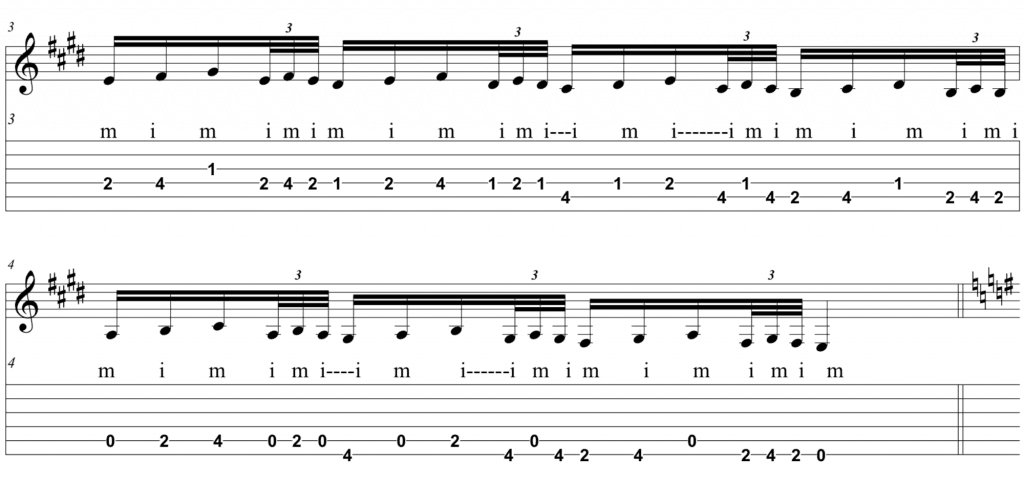

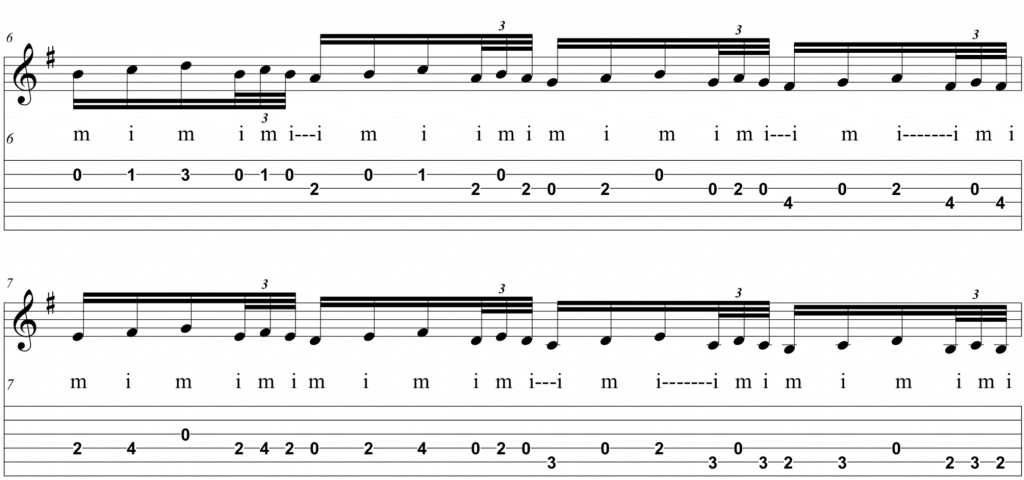

Craig:
Any word on a Volume 2? Anything else you’re planning on publishing?
Berto:
Volume 2 is going to dive deep into my personal take on CAGED systems. Knowing the fretboard is a useful tool and the Segovia scales are almost useless in a real world situation.
This will be another book of my own personal routine that involves the main keys we play in as guitarists and the patterns that kick my ass on a daily basis!
I also plan to publish many of my own original compositions this year. On my storefront you’ll also find a handful of my transcriptions of my friend Jose Luis de la Paz. Also a complete technique book with video for studies that molded his hands. Berto’s Flamenco Transcription Storefront
Flamenco Pacifico
Craig:
When I contacted you, you said you were currently on tour. Is that with Flamenco Pacifico? What are you up to currently?
Berto:
Currently, I am obsessed with skating as much as possible now that we are finally getting some dry weather! This winter was a real bitch especially after finishing the Castelnuovo-Tedesco concerto in December.
Working with the Oakland Youth Symphony
I happily just returned from 10 days in San Francisco. I was working with Jose Luis de la Paz and the Oakland Youth Symphony. We were there mainly to perform a few movements from Suite Avalon. This suite is a huge work that I put a ton of time into transcribing (over 500 hours).
It’s a 48 minute concerto for Flamenco guitar and Orchestra scored by Alex Conde. We debuted it a few years ago in Miami. Here’s a video of the process:
While we were there, we played a house concert. Also did some film scoring for the movie “Finding Compas” starring Farruquito, and hung out with some friends.
It was a much needed trip out of rainy Portland. Flamenco Pacifico is currently on sabbatical till our Fall tour this year. In the meantime though I’m working on releasing a few singles along with music transcriptions.
The 2 Mic for Guitarists
In the next few months I’ll be preparing for a joint benefit concert with the Los Angeles Guitar Quartet and Adam Del Monte. The concert is in Paradise, CA.
Our microphone endorser The2Mic is hosting this to help the fire victims of the Paradise Wildfire from last year.
Craig:
Where can my readers find your music. (Your preferred place for them to buy it etc..)
Berto:
That’s a good question! Everyone seems to have their own preference these days. To stream or not to stream? The Flamenco Pacifico album is up on all platforms so it’s up to them!
Berto Boyd Music Downloads
Flamenco Pacifico is now available for digital download!
CdBaby: http://bit.ly/2l8Jts9
iTunes: http://bit.ly/2lSIPDI
Craig:
Anything else you’d like to promote or talk about?
Berto:
Follow me on social media and turn those on notifications on!
Instagram: @BertoBoyd
Facebook: @Bertoguitarra @flamencopacifico @corvallisguitarsociety
Youtube: Flamenco Guitar Class
Berto Boyd on Skateboarding
Craig:
Ok, last question I promise… I have to ask about skating. I started skating again about 2 years ago after nearly 30 years off the board. Maybe it was my mid-life crisis but I’m still going a few times per week and I love it!
I’m back to dropping in and carving bowls again but it was certainly a struggle at first.
What keeps you skating? Is it something you’ve always done or did you start up again later like I did?
Berto:
After my 80’s skateboarding obsession, I ended up mostly surfing in the 90’s. This was due to the surf being way better than the skate scene in Ventura, CA.
I stopped skating and surfing altogether around 2000. I wanted to focus on the guitar career. Then I picked up skating again in 2013 when I moved to Oregon and saw Dreamland’s Lincoln City Skatepark.
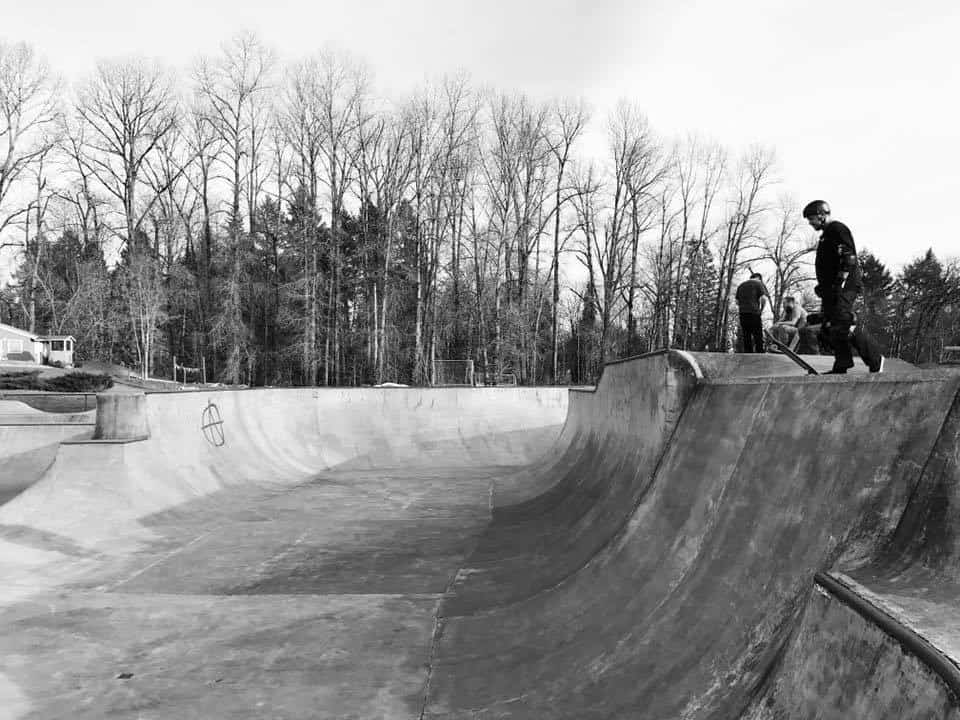
I grew up skating pretty janky stuff and had never seen anything this amazing and huge. There are over 100 skateparks in the state of Oregon and now I’m totally hooked again.
Starting a Skateboarding Non-Profit
I started a skateboard school that ended up lining up w nonprofit. http://bcskateboardingalliance.org/about/ We raised over 100k with our activities in 2018!
At least a few times a week you’ll find me at one of the amazing Dreamland or Grindline parks in Oregon and Southern WA. I feel the same stoke as I did as when I was 13. It is my fountain of youth!
Craig:
That’s awesome! I’m about to head out for a skate session myself today. Thank you so much for the interview, lesson and excerpt from your book!
Craig Smith is a professional Guitarist, Teacher, and Writer living in Sanford, Florida. Craig has taught guitar lessons, performed 200+ gigs per year for nearly 30 years, and published 4 guitar instructional books. When he’s not gigging or writing, you may find him by the pool with his wife Celeste, 4 Chihuahuas, and a drink. 🎸
